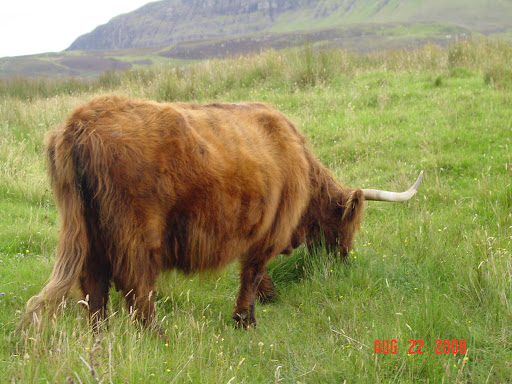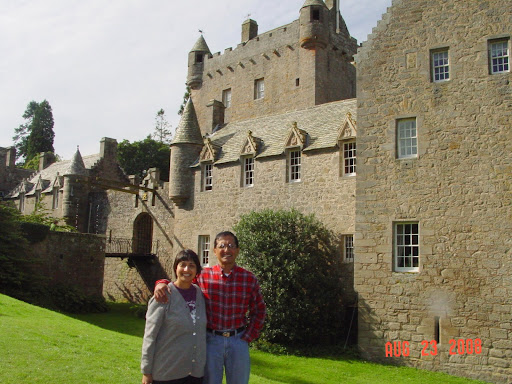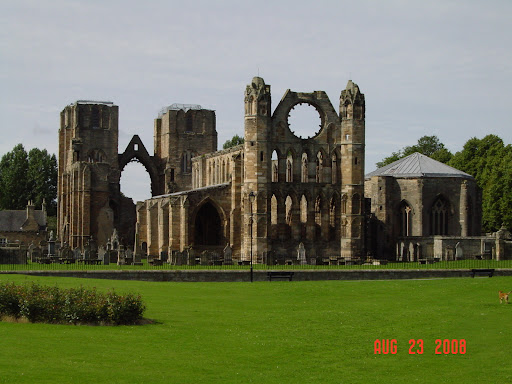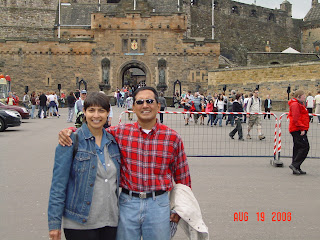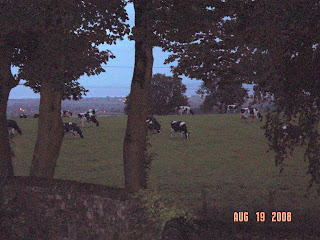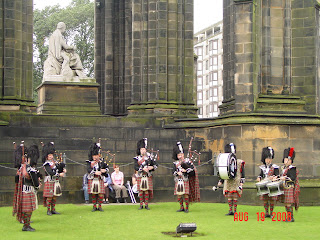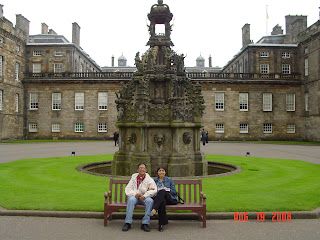The Isle of Skye–Investigating the Inner Hebrides:
At Eileen Donan Castle on teh Banks of Loch Druied en route to the Isle of Skye
Great weather made our exploration of the Inner Hebrides quite unforgettable. We awoke to a spectacular view of Ben Nevis from the bedroom window of our Quaich Cottage B&B and couldn’t resist taking pictures of the cloud-enshrouded peak. After showering quickly, we went downstairs to the dining room for our full Scottish breakfast that included two venison sausages which both Llew and I found very delicious.
We soon hit the road to Loch Ness and drove northwards, passing by the famous Caledonian Canal where it began at the little village of Banavie. The drive was just delightful. The area is simply chocful of lakes, all of which reflect the green vegetation of the mountain slopes. It was very reminiscent of the Canadian Rockies and Llew and I swore we could well have been there.
In Search of Nessie–the Loch Ness Monster:
Before long, we spied the southernmost shores of the famous Loch Ness and joined hordes of tourists in attempts to spy the infamous Nessie, as the Loch Ness monster is known. The road towards Invermorriston curved sharply making driving both strenuous and rather slow. En route, we passed by the famous Uruquart Castle (left) whose ramparts jut out into the lake. Lack of time did not allow us to explore the castle in its entirety, but we did stop to take pictures on the shore. There was nary a ripple on the lake’s surface—so any hopes of catching a glimpse of the elusive Nessie died immediately!
Off to the Isle of Skye:
Back on the road, headed towards the Kyle of Localsh and the Skye Bridge that would take us towards the islands of the Inner Hebrides, we stopped our car to give a ride to a hitchhiker named Joseph who happened to be an Irishman who had missed his bus to the Isle of Skye and was very grateful for the lift.
Chatting with him along the way took us past the famous Five Sisters of Kintail (gentle mountain slopes clad in green) and eventually the banks of Loch Duich on which the most photographed castle in Scotland (after Edinburgh’s)—Eileen Donan (pronounced ‘Doonin’) Castle offered wonderful photo opportunities of which we made the most.
Then, we were racing towards the Isle of Skye desperate to make our 1. 30 lunch reservation at the famed Three Chimneys Restaurant at Dunvegan about which we had read in The New York Times, three weeks ago. A quick call to them (thanks to my cell phone) made it clear that we would be unable to reach the restaurant in time and that they were unable to keep their kitchen open for us. Unable to keep our disappointment at bay, we decided to stop at the largest town on the Isle of Skye called Portree to eat ourselves a consolation lunch at a nearby bistro.
Lunch at Picture-Perfect Portree:
Skye is truly spectacular and reminded us very often of the western shores of Ireland around Connemara and Achill Island. The landscape changes dramatically presenting the motorist with the stark steeply rising mountain faces of the Cuillin Hills that are draped in a very light green but completely lack the presence of trees. Apart from flocks of sheep and brown cows that graze placidly along the slopes, there is no sign of any life. On the winding narrow roads that lead ever northwards to the more remote stretches of the island, there is barely any traffic. This is the point in Scotland when the lochs meet the ocean and the land and seascapes working in collusion are just stupendous. When we did reach Portree (above left) after dropping Joseph off at the crossroad, we arrived at a small bistro called The Bistro on the Main where we enjoyed a very good lunch indeed—glasses of Isle of Skye beer (“made with porridge oats!”) and prawn sandwiches for Llew and Fish and Chips (superbly fried haddock) for me.
Replete with our meal, we browsed around the stores and bought a few souvenirs before getting into the car again to undertake a loop around the northern reaches of the Isle of Skye where the natural scenery is most noted.
Here we were rewarded by frequent glimpses of the ocean punctuated by landscapes that looked more like moonscapes (left) .
We also saw a few of the famous Highland breed of golden cattle that sport a very shaggy mane and long curving horns. They passed right by our car doors allowing us to take a few good pictures (below left).
Having seen some of the most interesting parts of Skye, we made our way back towards Invermorriston passing by the Five Sisters of Kintail once again and admiring their rugged faces. Then, we were headed northwards towards Inverness where we hoped to find our Eilidh Bed and Breakfast before it got too dark. No reason to fear. Back on the shores of Loch Lomond a slight drizzle began but our car ate up the miles bravely and brought us into the town where we very easily found our abode for the night. Settling in our room, we took the suggestion of Ray, the owner of the house, that we take a walk towards the center of the city and the banks of the River Ness.
In and Around Inverness:
Indeed, Nessie makes her presence felt all around this area and the Ness Bridge that spans the river dividing the city in half offered wonderful floodlit views of the Castle of Inverness and the lovely old stone clad buildings that lined the banks of the river—buildings that turned out to be the Palace Hotel and Columba Hotel. Crossing the bridge, we arrived in the Town Center and wound our way through attractive shops that sold woolen items, postcards and a variety of souvenirs including Scotch whiskey. This corridor of Scotland, along the banks of the river Spey, is noted for its distilleries, and no doubt, we shall pass by and visit a couple of distilleries tomorrow. Indeed, we loved Inverness—it had the old-fashioned ambience of Edinburgh without the frenzy of the crowds and the dignity of Glasgow without its chaos. Our walk took us deeper into town and as darkness fell over the city, the golden orbs of the lamps that lined the River Ness’ banks, were reflected in the waters flowing softly downstream. The city was atmospheric in the extreme and both Llew and I fell in love with it immediately.
Then, twenty minutes later, we were back at our B&B, eating a sandwich and sundae dinner but not before we helped ourselves to a wee dram of Scotch whiskey which our host Ray told us represented a traditional Scottish welcome! It was warming indeed and reminded us of the brandy that our Mothers gave us when we were kids plagued by colds! A spot of TV later, news round-ups followed by some glimpses of the Highlights of the Beijing Olympics which are on right now, took us off to sleep.
To follow us on the next leg on our travels, please click on




